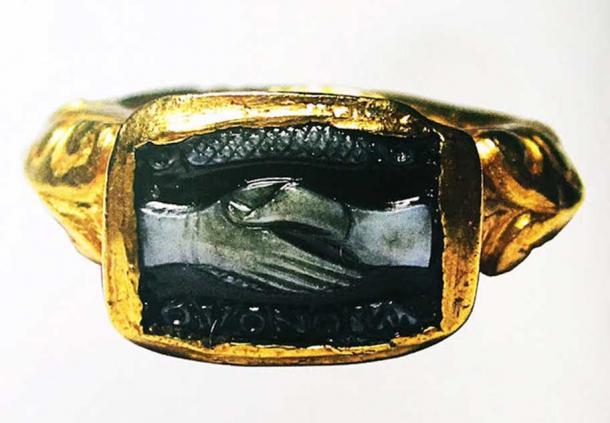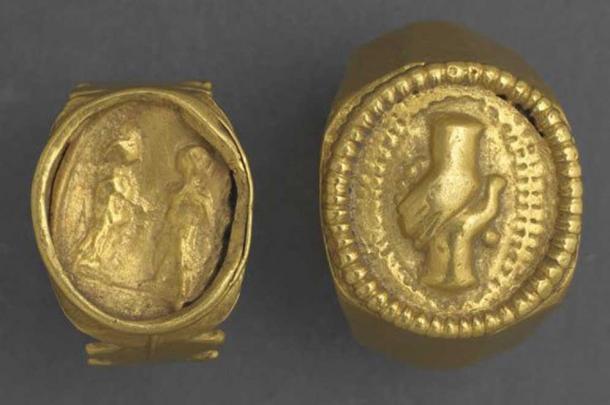Roman Engagement and Wedding Rings: Joining Hands and Hearts
The use of engagement rings and wedding rings are common in Western culture to indicate a person’s relationship status. This tradition may be traced back to ancient times, in particular, to the Roman period. Whilst these rings have their origins in either ancient Egypt or ancient Greece, it was under the Romans that detailed legal requirements for engagements, weddings, and divorce were first instituted. Therefore, we have an idea of how wedding rings functioned in ancient Rome, and how they fit into the customs of that society.
Legalities of Roman Marriage and Engagement Rings
In ancient Rome, a marriage would have been called justae nuptiae, justum matrionium or ligitimum matrimonium. Marriages had to conform to Roman law. The term connubium, for instance, denotes the legal right to get married, and this was a requirement before people could wed. Not everyone had connubium. Such individuals include people who were already married, eunuchs, and couples within the bounds of certain blood relationships. There were also other laws governing marriage in ancient Rome, including the acquisition of parental consent before a marriage, and a minimum age for marriage (12 for females and 14 for males).
Fragment from the front of a sarcophagus showing a Roman marriage ceremony. (CC BY SA 4.0) A Roman woman should receive both engagement and wedding rings as part of marriage law.
Given that marriage in ancient Rome was something that required strict adherence to law, it may not be surprising that it was also regarded as a contract. The giving of engagement rings in ancient Rome may be seen in this light, i.e. as a public marker that a contract has been made between the couple, as well as between their families. In addition, Roman engagement rings indicated that a woman was about to pass from the ownership of one man (her father) to another (her future husband). Therefore, only women wore engagement rings in ancient Rome.
- Why Do Couples Exchange Rings with Vows? The Elusive Ancient Origins of Wedding Rings
- Magical Rings and Their Mystical Powers
- Putting a Price on Marriage: The Long-standing Custom of Dowries

A Roman gold ring from the 3rd century AD depicting the figure of Cupid (“desire” –god of love) holding a ball, one leg on a rock. Walters Art Museum. (CC0)
Two Rings and Two Symbols for Marriage
Women in ancient Roman society were given two wedding rings, an iron one and a gold one. The first of these was worn at home, whilst the second was worn in public to impress people. Iron was chosen as the material for these rings as it was meant to symbolize strength and permanence.

Roman Key wedding ring. This ring was made of iron and worn by the wife. (Rama/CC BY SA 2.0 fr)
Gold was another material used by the Romans to make wedding rings - as a symbol of wealth. Whilst sumptuary laws prohibited the lower classes from wearing gold rings, they were difficult to enforce, and even slaves were recorded to have plated their iron rings with gold.

An elaborate gold and onyx Roman wedding ring from the 3rd century. (Argyor)
Gold wedding rings became especially prominent from the 3rd and 4th centuries AD onwards. During this period, gold rings became more elaborate and sumptuous, an indication of an owner’s wealth, as well as a craftsman’s skill. The most common type of ring associated with Roman marriages was the ‘fede’ ring, which had a design showing a pair of clasped hands, or an entwined couple.

Roman gold fede rings from the 2nd or 3rd century. The clasped hands design was popular for Roman wedding rings. (CC BY NC SA 4.0)
Passing On Marriage Traditions
These rings have remained popular over the centuries, and are still part of the engagement and wedding ring traditions of Italy today. It may be added that the Romans believed a nerve ran directly from the fourth finger (the ring finger) of the left hand directly to the heart. Due to this, wedding rings are worn on this finger, a tradition that has also continued till today.
- The Ring of Senicianus: One Ring to Rule Them All
- Ghost Marriages: Love For the Living and the Deceased
- The ancient fairy tale of Cupid and Psyche, where love endures against all odds
The Romans were also the first people who had their engagement / wedding rings engraved. One example of this practice can be seen on a ‘fede’ ring displayed in the British Museum in London. The words ‘ Te amo parum’ were found to have been engraved on this ring. This phrase meant ‘I love you too little’ or ‘I do not love you enough’. One sweet interpretation of this message is that the giver of the ring is unable to love his beloved enough because it would have been impossible to love her as much as she deserved.

Gold finger-ring set with a nicolo intaglio in the form of a truncated pyramid, engraved with a palm-branch and inscribed in Latin: "I love you too little" (Te am parum). (CC BY-NC-SA 4.0) This is one example of a Roman fede ring.
Top image: A Roman Ring with Linked Hands – this was a popular design for Roman wedding rings. Source: West Semitic Research Project/University of Southern Carolina
By Wu Mingren
References
Andrews, C., 2017. Engagement ring tradition and its place in Italian culture traditions. [Online]
Available at: http://www.explore-italian-culture.com/engagement-ring-tradition.html
Beard, M., 2012. Meeting the Romans at the British Museum. [Online]
Available at: https://blog.britishmuseum.org/2012/04/20/meeting-the-romans-at-the-british-museum-2/
Noreen, 2010. The Origins of Wedding Rings and Why They're Worn on the 4th Finger of the Left Hand. [Online]
Available at: http://www.todayifoundout.com/index.php/2010/09/the-origin-of-wedding-rings-and-why-theyre-worn-on-the-4th-finger-of-the-left-hand/
Nowak, C. & Bare, K., 2017. Here’s the Real Reason We Propose With Engagement Rings. [Online]
Available at: http://www.rd.com/advice/relationships/history-of-engagement-rings/
With These Rings, 2017. The History of the Wedding Band. [Online]
Available at: http://withtheseringshandmade.com/history-of-wedding-rings/
Withey, A., 2015. Roman Wedding Rings. [Online]
Available at: http://www.jewelpedia.net/roman-wedding-rings/
www.bustle.com, 2017. A History Of Engagement Ring Trends, From The Roman Era To Today. [Online]
Available at: https://www.bustle.com/articles/68013-a-history-of-engagement-ring-trends-from-the-roman-era-to-today




















